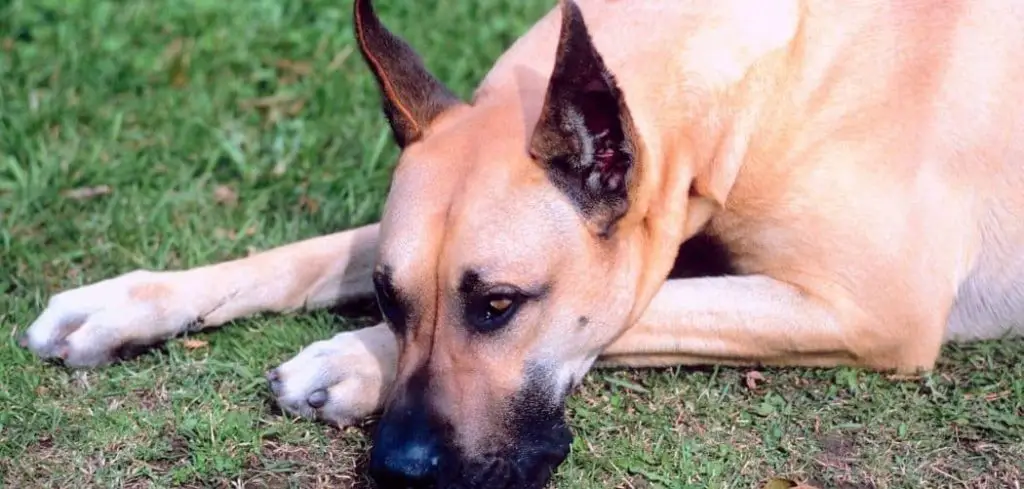Hair loss in patches accompanied by scabs in an old dog can indicate underlying skin or systemic health issues that require attention.
While some shedding is normal as dogs age, sudden or patchy hair loss with scabs is often a sign of underlying medical conditions.
Recognizing the causes early helps dog owners take steps to protect their dog’s skin, comfort, and overall health.
We outline the common causes of hair loss in patches and scabs in old dogs, what you can do, and when to seek veterinary help.
Old Dog Losing Hair in Patches and Scabs — Why It Happens
When an old dog is losing hair in patches with scabs, it’s usually a sign of an underlying skin problem rather than normal aging. Common causes include allergies (to food, fleas, or the environment), skin infections from bacteria or fungi, mange caused by mites, or hormonal issues such as Cushing’s disease or hypothyroidism. The scabs typically form from scratching, licking, or secondary infections due to irritation.

Old Dog Losing Hair in Patches and Scabs: Common Causes
Flea Infestation
Fleas are a frequent cause of patchy hair loss and scabs in senior dogs. Flea bites trigger intense itching, causing dogs to scratch and bite at their skin, resulting in hair loss and scab formation.
you may notice tiny black specks (flea dirt), red bumps, or areas of irritation, often around the tail, back, and belly.
Severe infestations can lead to secondary infections and significant discomfort.
Read more: Old Dog Losing Hair (How to support your senior dog)
Allergies
Old dogs may develop allergies to food, environmental factors, or contact irritants.
Allergic reactions often cause itching, redness, and hair loss in specific areas, which can progress to scabs from scratching or licking. Signs include recurrent ear infections, watery eyes, or frequent paw licking.
Chronic allergies compromise the skin barrier, increasing the risk of bacterial or fungal infections.
Fungal or Bacterial Infections
Bacterial and fungal infections, including ringworm, can cause circular patches of hair loss and scabs.
These infections may develop secondary to scratching from another condition or occur independently.
You may notice redness, flaking, odor, or crusty skin. Prompt diagnosis and treatment are vital, as infections can worsen and may be contagious to other pets or humans.
Hormonal Imbalances
Conditions such as hypothyroidism or Cushing’s disease can lead to thinning hair, patchy hair loss, and scab formation.
Hypothyroidism often causes symmetrical hair loss along the trunk, while Cushing’s disease may produce thinning skin and easy bruising.
These conditions also impact metabolism and immune function, making the skin more susceptible to infections.
Parasites Beyond Fleas
Mites, including mange-causing species, can lead to severe itching, hair loss, and scabs in older dogs. Demodex or sarcoptic mange is often localized initially but can spread if untreated.
Signs include redness, hairless patches, thickened skin, and persistent scratching. Early veterinary intervention is crucial to prevent progression and secondary infections.
Nutritional Deficiencies
Poor nutrition or malabsorption may manifest as brittle hair, patchy hair loss, and scabs.
Senior dogs with reduced appetite, dental issues, or chronic disease may not get enough protein, fatty acids, or essential vitamins for healthy skin and coat.
Signs include dull coat, flaky or scaly skin, and delayed healing of minor wounds.
What to Do If Your Dog Is Old Dog Losing Hair in Patches and Scabs
Regularly examine your dog’s skin for signs of irritation, redness, or scabs. Early detection helps prevent worsening and allows timely veterinary care.
Maintain flea and parasite control with vet-recommended products, as these can prevent itching and secondary infections.
Feed a balanced, high-quality diet tailored to senior dogs to support skin health and coat regeneration. Supplements with omega-3 fatty acids may be recommended.
Avoid harsh shampoos or grooming products that can irritate sensitive skin, and use gentle bathing routines as advised by your vet.
Consult your veterinarian promptly for persistent or worsening hair loss, scabs, or signs of infection. Diagnostic tests may be necessary to identify allergies, hormonal imbalances, or infections and guide effective treatment.
When to Call or Visit Your Vet
Seek veterinary care immediately if scabs are spreading, your dog seems in pain, or hair loss is rapid.
Contact your vet if there is swelling, discharge, bleeding, or foul odor from affected areas, which may indicate infection.
Persistent itching, lethargy, or changes in appetite alongside hair loss require professional evaluation to rule out systemic illnesses.
Early treatment prevents secondary infections, reduces discomfort, and improves skin healing in senior dogs.
Read more: Old Dog Losing Teeth (Reasons it happens)
Key Takeaway
Patchy hair loss and scabs in an old dog can result from fleas, allergies, infections, hormonal issues, parasites, or nutritional deficiencies.
Monitoring your dog’s skin, maintaining parasite control, providing proper nutrition, and seeking veterinary evaluation for persistent problems are essential steps to preserve skin health, comfort, and overall wellness.
Prompt recognition and intervention help ensure your senior dog remains comfortable, healthy, and happy.
